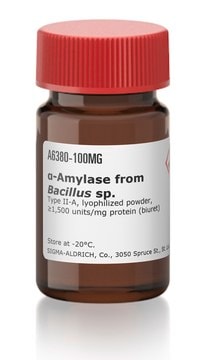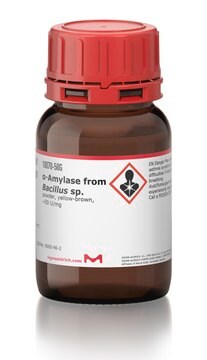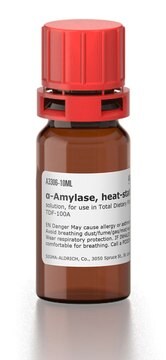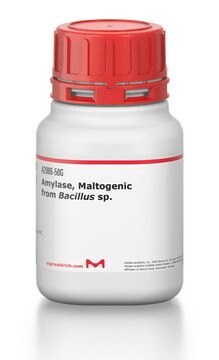A6814
α-Amylase from Bacillus sp.
powder, ≥400 units/mg protein (Lowry)
Sinonimo/i:
1,4-α-D-Glucan-glucanohydrolase
Autenticatiper visualizzare i prezzi riservati alla tua organizzazione & contrattuali
About This Item
Prodotti consigliati
Origine biologica
Bacillus sp.
Livello qualitativo
Stato
powder
Attività specifica
≥400 units/mg protein (Lowry)
PM
58-62 kDa
Solubilità
H2O: soluble 1.0 mg/mL
Temperatura di conservazione
−20°C
Cerchi prodotti simili? Visita Guida al confronto tra prodotti
Categorie correlate
Applicazioni
α-Amylase is used to hydrolyze α bonds of α-linked polysaccharides, such as starch and glycogen. α-Amylase, from Sigma, has been used in various plant studies, such as metabolism studies in Arabidopsis . α-has also been also used to study the ability of corn and starch to protect enzyme activity. The enzyme has been used to compare the effects of bacterial and fungal α-amylase and scalded flour on bread quality and shelflife. It has also been used to determine the optimal levels of these components in order to achieve maximum volume and bread freshness. Furthermore, it has been used to digest hydroxypropylated starch in Korean waxy rice cake to retard retrogradation.
Azioni biochim/fisiol
α-Amylase hydrolyzes the α-(1,4) glucan linkages in polysaccharides of three or more α-(1,4) linked D-glucose units. Natural substrates such as starch and glycogen are broken down into glucose and maltose. α -amylase, isolated from Bacillus subtilis is a dimer and has a monomer molecular weight of 48.9 kDa. α-Amylase is a metalloprotein and contains atleast one mol of calcium ion. The presence of calcium ion increases the stability of the enzyme towards denaturation by heat, acid, or urea. The pH range for activity of this product is 5.0 to 7.5, with the optimum pH range being 6.0-7.0. This product is stable from pH 5.0 to 10.0. The optimum temperature range is 65-75 °C. The effective temperature range is up to 90 °C.
Qualità
Contains starch as an extender.
Definizione di unità
One unit will liberate 1.0 mg of maltose from starch in 3 min at pH 6.9 at 20 °C.
Altre note
View more information on enzymes for complex carbohydrate analysis at www.sigma-aldrich.com/enzymeexplorer
Substrato
N° Catalogo
Descrizione
Determinazione del prezzo
Avvertenze
Danger
Indicazioni di pericolo
Consigli di prudenza
Classi di pericolo
Resp. Sens. 1
Codice della classe di stoccaggio
11 - Combustible Solids
Classe di pericolosità dell'acqua (WGK)
WGK 1
Punto d’infiammabilità (°F)
Not applicable
Punto d’infiammabilità (°C)
Not applicable
Dispositivi di protezione individuale
dust mask type N95 (US), Eyeshields, Faceshields, Gloves
Scegli una delle versioni più recenti:
Possiedi già questo prodotto?
I documenti relativi ai prodotti acquistati recentemente sono disponibili nell’Archivio dei documenti.
I clienti hanno visto anche
Utilization of Hydroxypropylated Waxy Rice and Corn Starches in Korean Waxy Rice Cake to Retard Retrogradation
Han J-A, et al.
Cereal Chem., 82(1), 88-92 (2005)
Sylwia Głazowska et al.
Journal of experimental botany, 70(21), 6461-6473 (2019-09-11)
Plants have evolved different strategies to utilize various forms of nitrogen (N) from the environment. While regulation of plant growth and development in response to application of inorganic N forms has been characterized, our knowledge about the effect on cell
Comparison of the effects of microbial α-amylases and scalded flour on bread quality
Hopek M, et al.
Acta Scientiarum Polonorum. Technologia Alimentaria, 5(1), 97-106 (2006)
Theoretical and Experimental Studies of the Effects of Heat, EDTA, and Enzyme Concentration on the Inactivation Rate of α-Amylase from Bacillus sp.
Lecker DN and Khan A
Biotechnol. Progress, 12(5), 713-717 (1996)
Usage of Enzyme Substrate to Protect the Activities of Cellulase, Protease and α-Amylase in Simulations of Monogastric Animal and Avian Sequential Total Tract Digestion
Wang HT and Hsu JT
Asian-Australasian Journal of Animal Sciences, 19(8), 1164-1173 (2006)
Il team dei nostri ricercatori vanta grande esperienza in tutte le aree della ricerca quali Life Science, scienza dei materiali, sintesi chimica, cromatografia, discipline analitiche, ecc..
Contatta l'Assistenza Tecnica.









